This Stunning Mountain Destination Is an Outdoor Adventurer's Paradise — With Epic Hikes, Scenic Campgrounds, and Waterfall Views
The Blue Ridge Mountains region is a 600-mile-long segment of the mighty Appalachian range. Like all Appalachians, these rock formations are far older than the Rockies, their counterpart to the west. While the Rockies are sharp and sheer, the Blue Ridge Mountains are rounded and relatively low, with more than a billion years of wind, rain, and snow behind them. They're famous for their bluish haze, which can appear deep ocean blue, pale purple, or somewhere in between.
Where Are the Blue Ridge Mountains?
Most definitions agree that the range stretches more than 600 miles from Georgia's Mount Oglethorpe to Carlisle, Pennsylvania. Between those two points, the ridge spans South Carolina, Tennessee, North Carolina, Virginia, and Maryland, and some maps include West Virginia and even Alabama and Kentucky. Yet its cultural heart and the bulk of its mass belong to North Carolina and Virginia.
The range is predominantly associated with the western parts of North Carolina and Virginia, so we'll focus on those two states in this guide to all things Blue Ridge, which includes when to go, where to hike, and more.
Best Times to Go to the Blue Ridge Mountains

Getty Images
Nature lovers will find year-round nirvana in the Blue Ridge Mountains, though spring, summer, and fall are the best times of year to visit for exuberant flora, pleasant weather, and an array of outdoor activities.
During the spring, the region bursts with green buds and wildflowers. Animals emerge and spring rains feed gushing streams and waterfalls. By April, most river tours have kicked off whitewater-rafting season (typically through September). Wildflower hikes and spring festivals are among the top things to do.
Temperatures climb in the summer, yet the elevation keeps humidity at bay. And spring's to-do checklist (camping, kayaking, fly-fishing, biking) grows even bigger, with swimming and local events like music festivals, farmers markets, and craft fairs.
In the fall, fiery colors blaze across the Blue Ridge. This is perhaps the most popular time of year to visit, as leaf-peepers pour in to see the region's famously beautiful fall foliage.
Many attractions shut down in the winter, though skiing and holiday festivities enter the equation. You can find several family-friendly ski resorts with relatively easy terrain, including North Carolina's Sugar and Beech mountains and Virginia's Wintergreen resort. The region takes on a magical appearance around Christmas, with small-town celebrations, holiday light displays at Asheville's Biltmore Estate, and Christmas train rides like the Blue Ridge Scenic Railway in Georgia and the Polar Express in North Carolina.
Where to Hike in the Blue Ridge Mountains
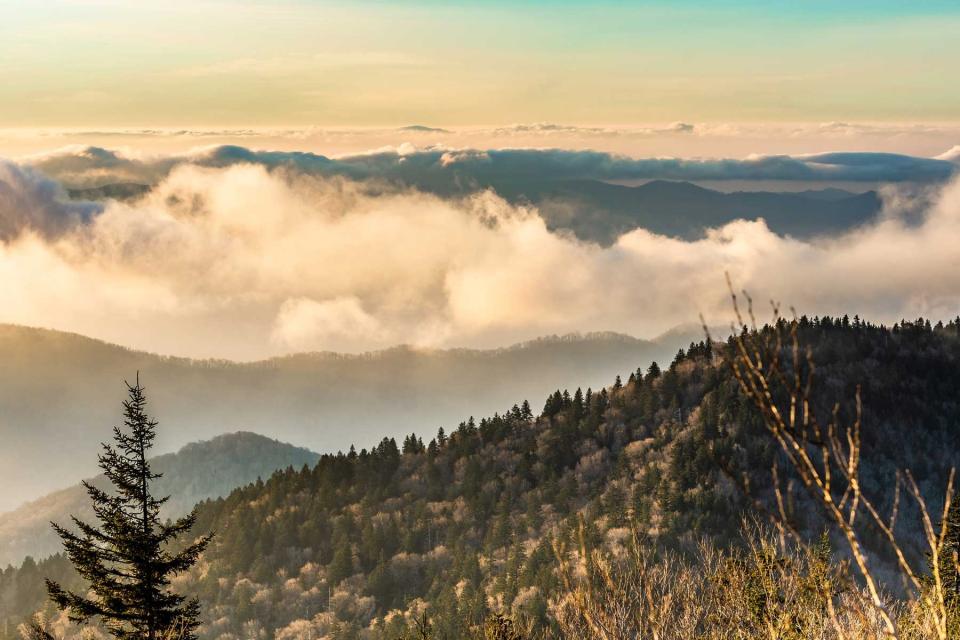
Getty Images
There's perhaps no better way to feel the life force of the Blue Ridge Mountains than to set out on one of its hiking trails. There are hundreds to choose from, many located off or near the popular Blue Ridge Parkway. (The long-distance Appalachian and Mountains-to-Sea trails both shadow sections of this famous drive.)
One such region, Virginia's Roanake Valley, has some of the most sought-after hiking spots in the U.S., including McAfee Knob (thought to be the most photographed site on the Appalachian Trail), panoramic Sharp Top and Tinker Cliffs, and rocky Devil's Marbleyard.
The north end the Blue Ridge Parkway brings you just near the waterfalls, wildflowers, and woodlands of Shenandoah National Park. Here, 500 miles of hiking trails crisscross 200,000 acres of protected land; the most popular route is Old Rag Circuit, a 9.4-mile loop that features rock scrambling and panoramic views from the summit.
Down closer to the North Carolina-Virginia border, you'll find Grayson Highlands State Park about an hour west of the Blue Ridge Parkway. This 4,500-acre park is often compared to the Scottish Highlands for its open meadows, mossy-floored spruce forests, mountain balds, and rocky ridgelines. You might even spot a wild pony grazing near a trail.
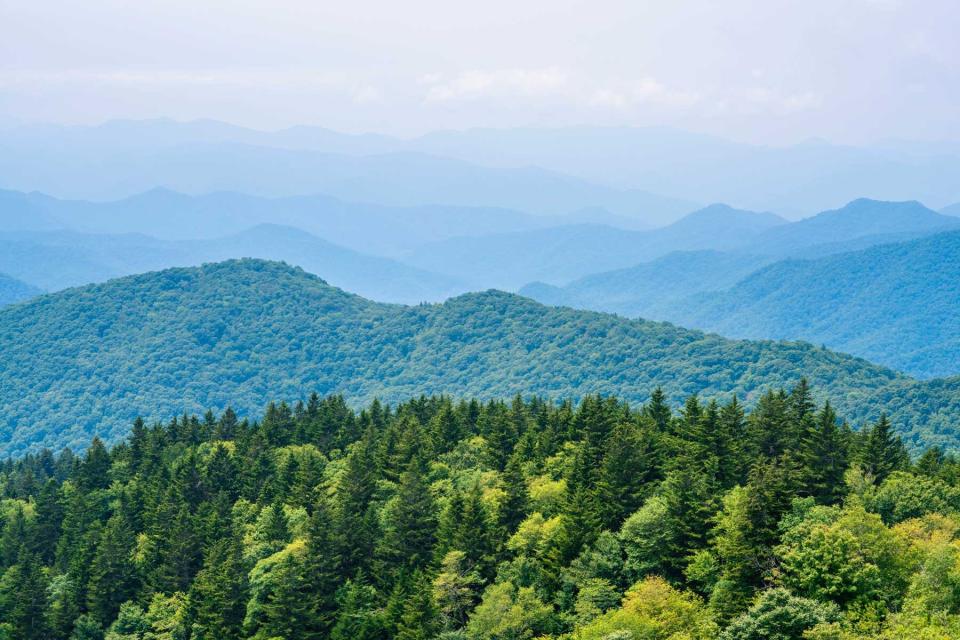
Getty Images
Part of the Appalachian Trail, the shrubby Roan Highlands section is a string of five separate summits. In the summer, this high-elevation area along the North Carolina-Tennessee border is full of rhododendrons, azaleas, and other wildflowers. (Tip: Don't even think about hiking here without a brimmed hat.) Like Grayson Highlands, this is worth a detour off the Blue Ridge Parkway.
Scooting south, you'll get to North Carolina's Linville Falls (within Linville Gorge Wilderness). It's the waterfall to see on the Blue Ridge Parkway, with three trails leading to the plunge from different viewpoints. Further down by milepost 408, you can access the Summit Trail of Mount Pisgah, which travels through oak forest to the scrubby peak. There's also the 16-mile Shut-In Trail, part of a route originally used by industrialist George Vanderbilt for hunting retreats (now part of the Mountains-to-Sea Trail).
And, of course, Great Smoky Mountains National Park, where the Blue Ridge Parkway ends (or begins, for northbound travelers), is rich with hiking options for all levels. The UNESCO-listed national park has 850 miles of trails; two favorites (both on the hard end of the spectrum) include Chimney Tops and Alum Cave trails. The easy-rated Laurel Falls Trail (blooming with the namesake mountain laurel each May) takes hikers to an 80-foot waterfall.
Things to Do in the Blue Ridge Mountains
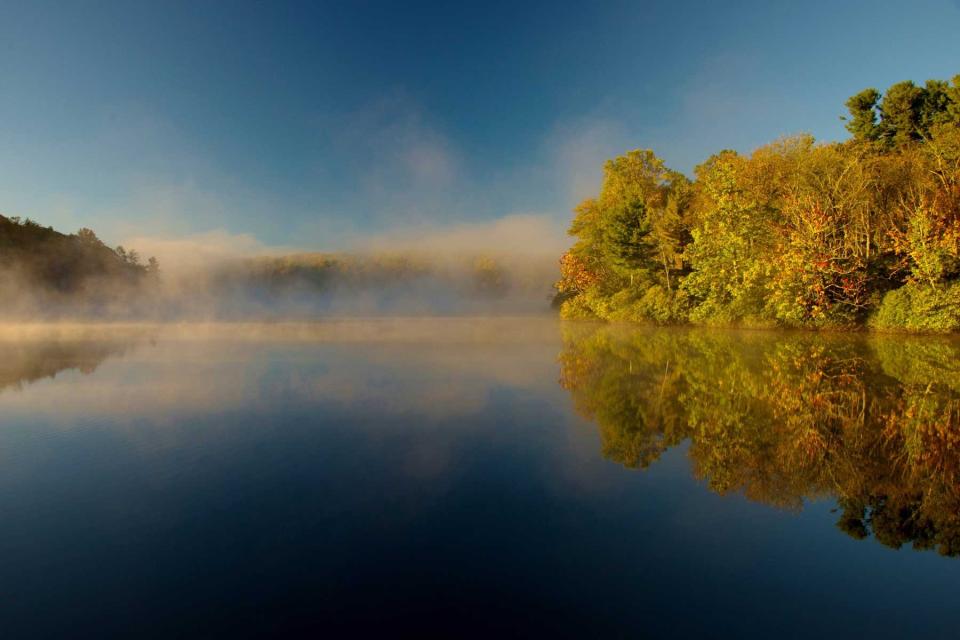
Larry Knupp/Getty Images
The Blue Ridge region provides an astonishing abundance of activities beyond hiking, too.
In the hotter months, there's nothing like cooling off in crisp, clear mountain water. Sliding Rock in North Carolina's Pisgah National Forest is a special summer favorite. Here, visitors line up to take their turn zipping down the natural 60-foot stone "sliding board" before plunging into the icy pool at the bottom.
Cool, clear mountain streams and lakes offer ample opportunities to reel in a fish as well. Fly-fishing fans will find mountain creeks, streams, and rivers teeming with trout (brook, brown, and rainbow), while those who prefer fishing the still waters of lakes and ponds might snag a largemouth bass, whitefish, or catfish.
One of the best ways to experience the surrounding mountain scenery is from the water. If you're cruising the Blue Ridge Parkway, pristine Price Lake (milepost 296.7) is a great pullover spot with boat and canoe rentals. The fast-moving currents of the French Broad River outside Asheville attract experienced paddlers and rafting tour groups. And the popular Deep Creek recreation area near Bryson City, North Carolina, features two tubing runs for both wild and leisurely rides.
One of the best biking trails in the country is found in a rural Blue Ridge corner of Virginia. The Virginia Creeper Trail is a former Native American footpath (once used by Daniel Boone) and early 1900s rail line whose steam engine trains once delivered lumber to thriving Virginia and North Carolina sawmills. The railroad corridor-turned-recreation trail rolls through farmland and mountain scenery, with a gentle grade for cyclists (and walkers, joggers, and horseback riders) of all levels.
Creek crossings, moonlit rides, and backcountry jaunts — you can find trail rides for all ages and experience levels throughout the Blue Ridge Mountains.
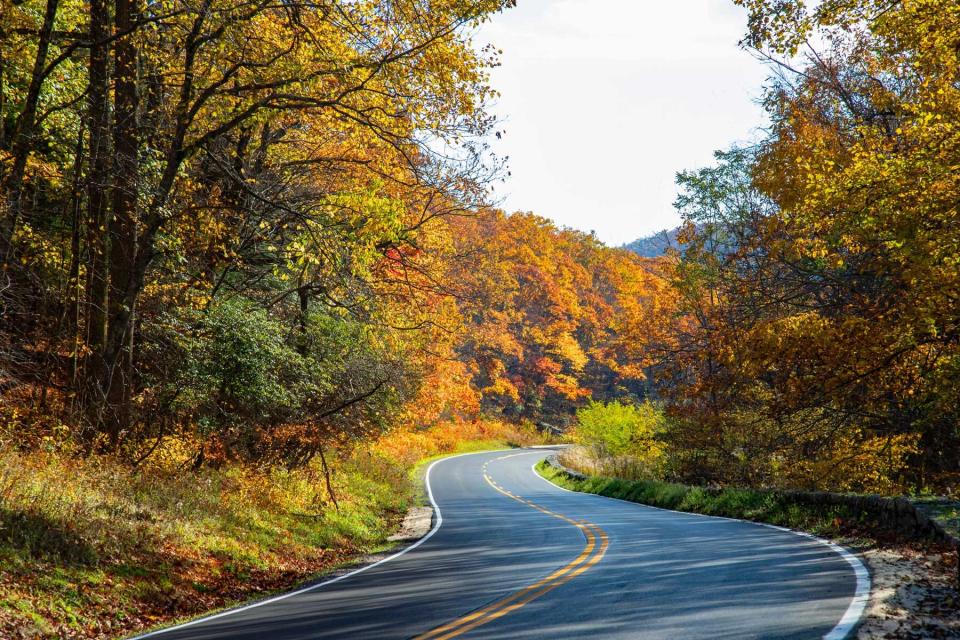
Getty Images
Just hitting the road in this part of the world is an unforgettable experience. There's the Blue Ridge Parkway, of course, as well as Shenandoah's famous Skyline Drive and the 42-mile Cherohala Skyway, a sports car and motorcycle magnet split between the high-altitude ridges of North Carolina and Tennessee. One stretch of U.S. 129, dubbed Tail of the Dragon, packs 318 curves into 11 miles. New River Valley Byway follows an old trail stamped out by buffalo, winding through Christmas farm country.
If mountain peaks and dizzying viewpoints still aren't high enough, you can go even further with an early morning hot-air balloon ride. Seeing Blue Ridge scenery from the sky is truly unparalleled.
The beauty of the Blue Ridge come fall — when the mountains are gleaming with turning leaves — indelibly impacts those who witness it. Colors first begin to change in the higher, cooler elevations around late September and early October, followed the lower elevations into November. The stunning display of vivid reds, oranges, and yellows makes October the busiest month on the Blue Ridge Parkway.
Where to Stay in the Blue Ridge Mountains
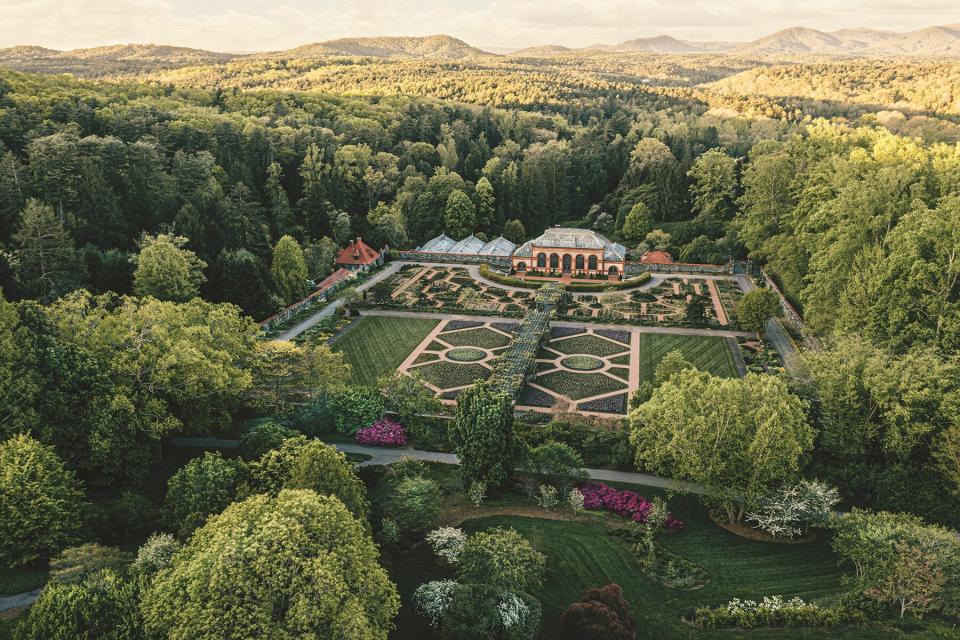
Courtesy of Biltmore
What Vanderbilt described as his "little mountain escape" is, in fact, a 250-room château and the largest private home in the U.S. The Biltmore and its 8,000 surrounding acres form one of the top attractions in the region. Tour its over-the-top rooms (see how many of the mansion's 65 fireplaces you can count) and Frederick Law Olmsted-designed gardens and grounds, which include a historic farm, on-site winery, 20 miles of bike and nature trails, and more.
History, culture, and natural beauty collide in Asheville, one of the most popular mountain home bases in the Blue Ridge. The well-loved Windsor Boutique Hotel puts guests in the center of Asheville's brewpub/vintage shop/indie restaurant heart. The famous Biltmore Estate, meanwhile, offers three lodging options — a wallet-friendly hotel, a high-end inn, and luxury cottages — all immensely popular. The views, spa, and fireplace-framed Great Hall of the 1913 Grove Park Inn (an Omni hotel) inspire reverence among travelers.
Yet many want to rent a cabin or pitch a tent. Perfectly located between Asheville, Biltmore, and the Blue Ridge Parkway, Mountain Springs Cabins lets you relax on your porch swing and grill out at night amid a sea of fireflies.
A UNESCO World Heritage site, Great Smoky Mountains National Park is famous for its natural beauty, extensive wildlife, and 850 miles of hiking trails. Nearby accommodations include cabin rentals, campgrounds (sites at in-park Cades Cove, Smokemont, and Balsam Mountain are in high demand), chain hotels, and rustic mountain retreats (like the Lodge at Tellico and LeConte Lodge). In a crook of the Cheoah River, River's Edge Treehouse Resort is a summer-camp-like collection of cabins between Great Smoky Mountains National Park and the pristine Nantahala National Forest.
The small North Carolina town of Bryson City makes a great home base for Great Smoky and Blue Ridge exploration. Bordering Great Smoky Mountains National Park on the banks of the Tuckasegee River, the scenic town has a great local scene that includes lovely places to stay like the charming Folkestone Inn, the boutique Everett Hotel (right on the historic town square), the group-friendly Calhoun House Inn & Suites, and the immersed-in-nature Lakeview at Fontana Inn & Treetop Soaking Cabanas.
This beautiful corner of North Carolina near the South Carolina-Georgia border is famous for its waterfall-heavy scenery — Dry Falls, Glen Falls, Cullasaja River Gorge, Bridal Veil Falls, Secret Falls, and Whitewater Falls, the highest waterfall east of the Rockies, are all worth a trip. A destination known for its natural beauty, the area has built an impressive tally of boutique hotels and lodges, including the reimagined motor courts of Hotel Cashiers and Skyline Lodge, as well as Fire Mountain, a mountaintop inn with cabins and tree houses.
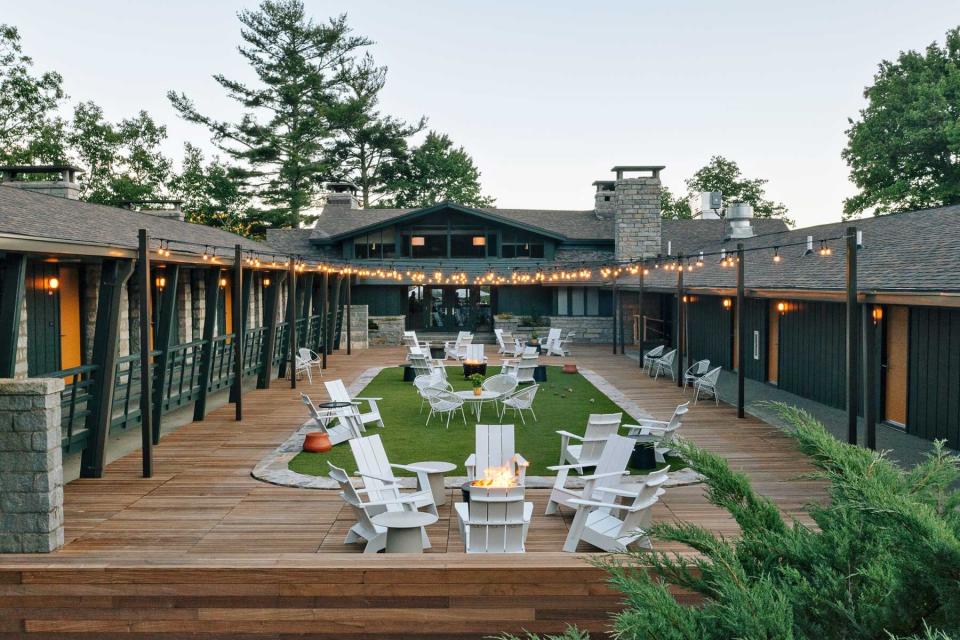
Andrew Cebulka/Courtesy of Skyline Lodge The courtyard lawn at the Skyline Lodge, in Highlands, North Carolina.
There are five seasonal campgrounds within the park boundaries, all amid picturesque mountains and pristine fishing streams. Big Meadows Campground is a good pick for first-timers, as it's near Harry F. Byrd, Sr. Visitor Center and the popular Dark Hollow Falls Trail, while Loft Mountain Campground at the top of Big Flat Mountain offers incredible sunrise and sunset views. Skyland Resort sits on the highest point of Skyline Drive, the gasp-inducing road that winds more than 100 miles through the park along the main mountain ridge.

